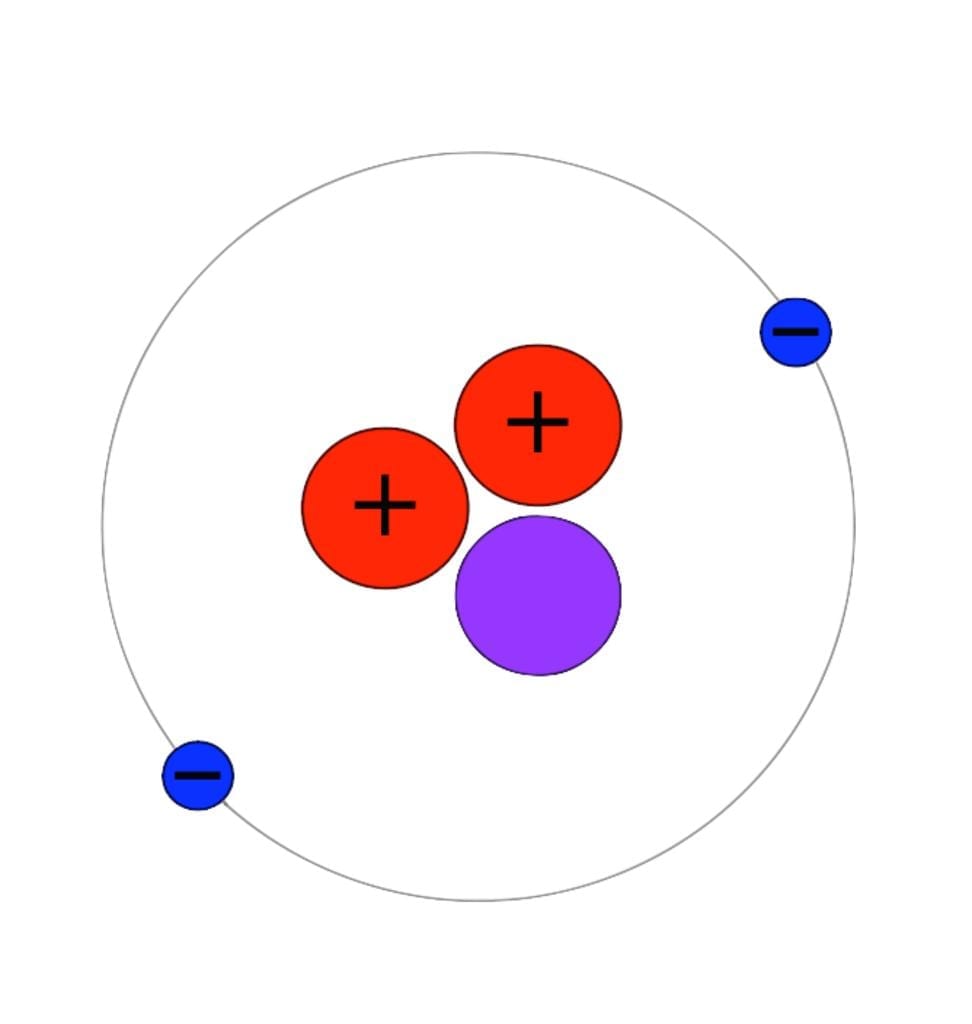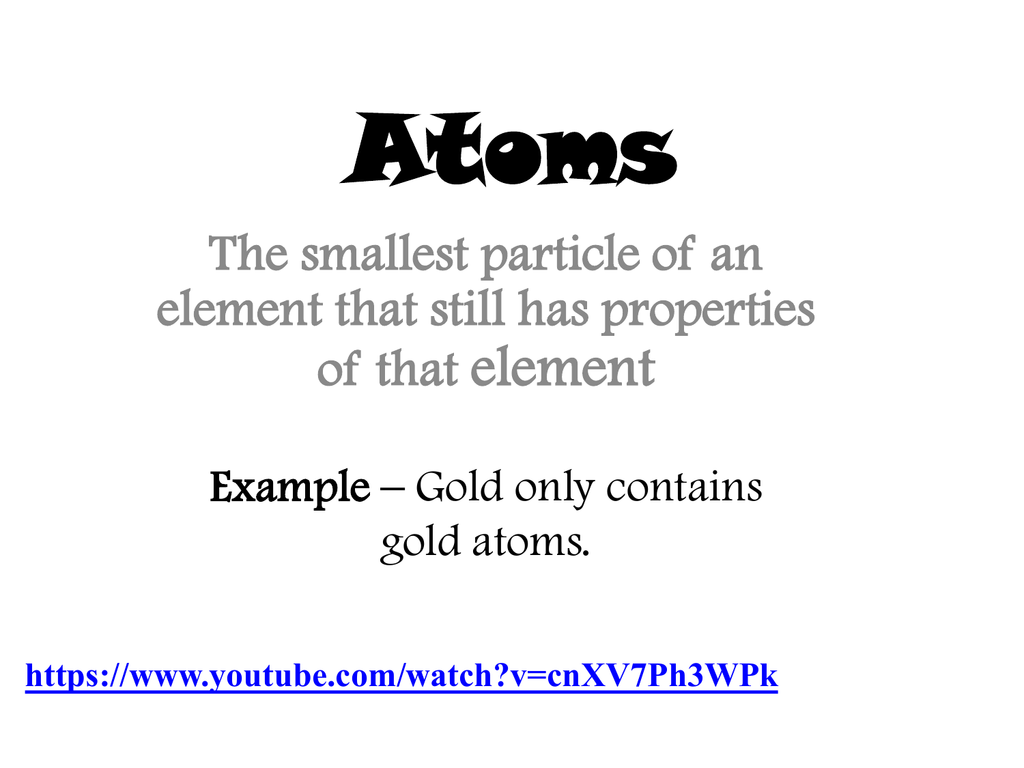
- Smallest Particle Of An Element
- Smallest Particle Of An Element That Can Enter Into A Chemical Change
- Smallest Particle Of An Element
- Smallest Particle Of An Element Are Called
from Wikipedia, the free encyclopedia
2
In chemistry and physics, an atom is the smallest particle of a chemical element that retains its chemical properties.
An atom consists of a dense nucleus of positively-charged protons and electrically-neutral neutrons, surrounded by a much larger electron cloud consisting of negatively-charged electrons.
An atom is electrically neutral if it has the same number of protons as electrons.
An atom is the smallest particle of an element still having the same chemical properties of the element. See the fact file below for more information on the atom or alternatively, you can download our 26-page Atom worksheet pack to utilise within the classroom or home environment. An atom is the smallest unit of ordinary matter that forms a chemical element.Every solid, liquid, gas, and plasma is composed of neutral or ionized atoms. Atoms are extremely small, typically around 100 picometers across. They are so small that accurately predicting their behavior using classical physics—as if they were tennis balls, for example—is not possible due to quantum effects. The smallest particle of an element would be an atom. Any smaller and it would not be an element, but something more basic. Atoms are made of Protons, Neutrons, and Electrons. Protons and Neutrons.
The number of protons in an atom defines the chemical element to which it belongs, while the number of neutrons determines the isotope of the element.
The first nuclei, including most of the helium and all of the deuterium in the universe, were theoretically created during big bang nucleosynthesis, about 3 minutes after the big bang.
The first atoms were theoretically created 380,000 years after the big bang, an epoch called recombination, when the universe cooled to allow electrons to become attached to nuclei.
Since then, atoms have been combined in stars through the process of nuclear fusion to generate atoms up to Iron.
A human hair is about 1 million carbon atoms wide.
Note: The above text is excerpted from the Wikipedia article 'Atom', which has been released under the GNU Free Documentation License.
For more information, see the following related content on ScienceDaily:
2
Smallest Transistor Switches Current With a Single Atom in Solid Electrolyte
Aug. 16, 2018 — Researchers have developed a single-atom transistor, the world's smallest. This quantum electronics component switches electrical current by controlled repositioning of a single atom, now also ...
Scientists Discover Why Silver Clusters Emit Light
Aug. 16, 2018 — Clusters of silver atoms captured in zeolites, a porous material with small channels and voids, have remarkable light emitting properties. They can be used for more efficient lighting applications as ...
Atom Interaction Discovery Valuable for Future Quantum Technologies
Apr. 24, 2019 — By breaking with conventionality, physicists have opened up new research and technology opportunities involving the basic building block of the world -- atoms. Researchers put one atom inside each of ...
Size Matters When It Comes to Atomic Properties
Mar. 18, 2021 — A study has yielded new answers to fundamental questions about the relationship between the size of an atom and its other properties, such as electronegativity and energy. The results pave the way ...
Breakthrough in Blending Metals
Sep. 24, 2018 — Researchers have found a way to create innovative materials by blending metals with precision control. Their approach, based on a concept called atom hybridization, opens up an unexplored area of ...
Quantum Wave in Helium Dimer Filmed for the First Time
Dec. 23, 2020 — For the first time, an international team of scientists has succeeded in filming quantum physical effects on a helium dimer as it breaks apart. The film shows the superposition of matter waves from ...
Discovery of Single Atom Structure Leads to More Efficient Catalyst
Jan. 14, 2019 — The discovery shows an efficiency rate that is up to 25 times higher than traditional catalysts made from larger iridium structures or ...
Controlling Chemical Reactions Near Absolute Zero
Oct. 9, 2018 — Chemists have demonstrated complete experimental control over a chemical reaction just above absolute ...
Simple Equation Directs Creation of Clean-Energy Catalysts
May 14, 2018 — New guidelines could steer the design of less costly, more efficient catalysts geared toward revving up the production of hydrogen as a renewable fuel. Using its equation, the team discovered several ...
More Goals in Quantum Soccer
Oct. 24, 2018 — Physicists have presented a method that may be suitable for the production of so-called quantum repeaters. These should improve the transmission of quantum information over long distances. The ...
- RELATED TERMS
- Big Bang nucleosynthesis
- Nucleosynthesis
- Cosmic microwave background radiation
- Subatomic particle
- Lewis structure in chemistry
- Electron
April 22, 2021
Apr. 1, 2021 — A single 'super photon' made up of many thousands of individual light particles: About ten years ago, researchers produced such an extreme aggregate state for the first time. ...
Mar. 16, 2021 — Researchers observed hummingbirds using 12 high-speed cameras, 6 pressure plates and 2176 microphones. The soft and complex feathered wings generate sound in a fashion ...
Smallest Particle Of An Element

Mar. 2, 2021 — New research shows that slight alterations in transfer-RNA molecules (tRNAs) allow them to self-assemble into a functional unit that can replicate information exponentially. ...
Feb. 23, 2021 — By discovering a new printable biomaterial that can mimic properties of brain tissue, researchers are now closer to ...
updated 12:56 pm ET
Laser Paintbrush Used to Create Miniature Masterpieces
Apr. 19, 2021 — Researchers are blurring the lines between science and art by showing how a laser can be used to create artistic masterpieces in a way that mirrors classical paints and brushes. The new technique not ...
Collaborative Research Could Help Fine-Tune the Production of Antimalarials, Chemo Drugs
Apr. 21, 2021 — Much of common pharmaceutical development today is the product of laborious cycles of tweaking and optimization. In each drug, a carefully concocted ...
Detailed Look at Intriguing Property of Chiral Materials
Apr. 21, 2021 — A new study is advancing scientists' understanding of magneto-chiral dichroism. The research focuses on light-matter interactions in chiral materials under a magnetic ...
Fighting Harmful Bacteria With Nanoparticles
Apr. 22, 2021 — Multi-resistant pathogens are a serious and increasing problem in today's medicine. Where antibiotics are ineffective, these bacteria can cause life-threatening infections. Researchers are currently ...
The Future Looks Bright for Infinitely Recyclable Plastic
Apr. 22, 2021 — Plastics are ubiquitous, but they're not practical. Less than 10% are recycled, and the other approximately 8 billion tons are creating a pollution crisis. Researchers are determined to change that. ...
Using Floodwaters to Weather Droughts
Apr. 21, 2021 — Using a new computer framework, scientists are able to project future floodwaters under a changing climate. The approach could help California water managers plan for and redirect floodwaters toward ...
Scientists Capture Image of an Electron's Orbit Within an Exciton
Apr. 21, 2021 — Researchers have captured an image showing the internal orbits, or spatial distribution, of particles in an exciton - a goal that had eluded scientists for almost a ...
Mechanical Engineers Develop New High-Performance Artificial Muscle Technology

Smallest Particle Of An Element That Can Enter Into A Chemical Change
Apr. 21, 2021 — Researchers have developed a new, high-performance artificial muscle technology. The new technology enables more human-like motion due to its ...
Aerial Photos Uncover an Invisible Fault in Chinese City

Smallest Particle Of An Element
Apr. 21, 2021 — Decades-old aerial photos of Yudong District, Datong City in Shanxi Province, Northern China have helped researchers in their search for a fault hidden underneath the city's buildings and cement ...
'Fingerprint' for 3D Printer Accurate 92% of Time
Smallest Particle Of An Element Are Called
Apr. 21, 2021 — New research shows 3D printers can be identified by thermodynamic properties, which could could aid intellectual property, ...




